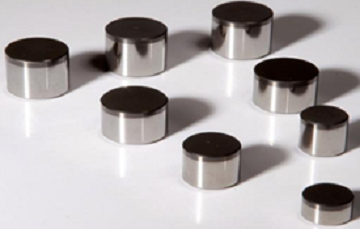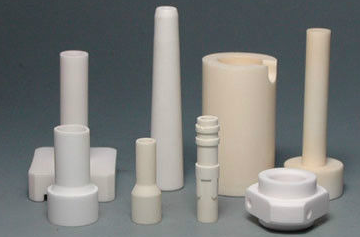What Are the Ceramic Materials With High Thermal Conductivity?
The thermal conductivity of ceramic materials plays an important role in its application. In a certain range, increasing the thermal conductivity of ceramic materials by specific methods will improve its ability of heat conduction, heat convection and heat radiation, so as to further expand its application field. Ceramic materials with high thermal conductivity are mainly composed of oxides, nitrides, carbides, and borides, such as polycrystalline diamond ceramics, aluminum nitride, beryllium oxide, silicon nitride, and silicon carbide.
Polycrystalline diamond (PCD)
Diamond has a strong thermal conductivity. The theoretical value of thermal conductivity of its single crystal is 1642W/m•K at room temperature, and the measured value is 2000W/m•K. However, large single crystal diamond is difficult to prepare and expensive. In the sintering process of polycrystalline diamond, sintering AIDS are often added to promote the bond between diamond powders so as to obtain high thermal conductivity PCD ceramics. However, the sintering assistant can catalyze the carbonization of diamond powder in the process of high-temperature sintering, so that polycrystalline diamond is no longer insulated. The diamond small single crystal is often added to thermal conductivity ceramics as a reinforcing material to improve the thermal conductivity of ceramics.
Polycrystalline diamond ceramics are both engineering materials and new functional materials. At present, polycrystalline diamond ceramics have been widely used in the fields of modern industry, national defense and high and new technology due to its excellent mechanical, thermal, chemical, acoustic, optical and electrical properties.

Silicon carbide
At present, silicon carbide (SiC) is an active thermal conducting ceramic material at home and abroad. The theoretical thermal conductivity of silicon carbide is very high, reaching 270W/m•K. However since the ratio of surface energy to interfacial energy of SiC ceramic materials is low, that is, the grain boundary energy is high, it is difficult to produce high purity and dense SiC ceramics by conventional sintering methods. Sintering AIDS must be added when conventional sintering methods are used, and sintering temperature must be above 2050 ℃ is achieved. However, this sintering condition will cause the growth of SiC grains and significantly reduce the mechanical properties of SiC ceramics.
Silicon carbide ceramics have been widely used in high-temperature bearings, bulletproof plates, nozzles, high-temperature corrosion resistant parts and high temperature and high-frequency range of electronic equipment parts and other fields.
![]()
Silicon nitride
Silicon nitride (Si3N4) ceramics have been paid more and more attention by researchers at home and abroad for their excellent properties such as high toughness, strong thermal shock resistance, good insulation, corrosion resistance, and non-toxicity. The bonding strength, average atomic mass and anharmonic vibration of silicon nitride ceramics are similar to those of SiC. The theoretical thermal conductivity of silicon nitride crystals is 200 ~ 320 W/m•K. However, since the structure of Si3N4 is more complex than that of aluminum nitride (AlN), and the scattering of phonons is larger, the thermal conductivity of sintered Si3N4 ceramics is far lower than that of Si3N4 single crystal in the present study, which also limits its scale promotion and application.
![]()
Beryllium Oxide
Beryllium oxide (BeO) belongs to hexagonal wurtzite structure, with a small distance between Be atoms and O atoms, small average atomic mass and dense atomic accumulation, which conforms to the conditions of Slack model with the
high thermal conductivity of single crystal. In 1971, Slack and Auaterrman tested the thermal conductivity of BeO ceramics and large BeO single crystal and calculated that the thermal conductivity of large BeO single crystal could reach up to 370 W/m•K. At present, the thermal conductivity of the prepared BeO ceramics can reach 280 W/m•K, which is 10 times higher than that of aluminum oxide (Al2O3) ceramics.
Beryllium oxide is widely used in aerospace, nuclear power, metallurgical engineering, electronics industry, rocket manufacturing and so on. BeO is widely used as carrier parts and assemblies in avionics conversion circuits and in aircraft and satellite communication systems; BeO ceramics have a particularly high thermal shock resistance and can be used in the fire pipe of jet aircraft; the metal-coated BeO plate has been used in the control system of the aircraft drive device; Ford and General Motors use metal-sprayed beryllium oxide linings in car ignition systems; BeO have good thermal conductivity and are easy to be miniaturized, so they have broad application prospects in the laser field. For example, BeO laser has higher efficiency and larger output power than quartz laser.

Aluminum nitride (AlN)
Aluminum nitride ceramics are the most widely used high thermal conductivity materials. The theoretical thermal conductivity of aluminum nitride single crystal can reach 3200W/m•K. However, due to the inescapable impurities and defects in the sintering process, these impurities produce various defects in the AlN lattice, which reduce the average freedom of phonons and thus greatly reduce their thermal conductivity. In addition to the effect of AlN lattice defects on thermal conductivity, grain size, morphology and the content and distribution of the second phase of grain boundary also have important effects on thermal conductivity of AlN ceramics. The larger the grain size, the greater the average freedom of phonons, and the higher the thermal conductivity of sintered AlN ceramics.
As a typical covalent complex, aluminum nitride has a high melting point, low atomic self-diffusion coefficient, and high grain boundary energy during sintering. Therefore, it is difficult to produce high purity AlN ceramics by conventional sintering methods. In addition, the addition of appropriate burn AIDS can also react with oxygen in the lattice to form a second phase, purify the AlN lattice and improve the thermal conductivity.

Common AlN ceramics sintering aids are yttrium oxide (Y2O3), calcium carbonate (CaCO3), calcium fluoride (CaF2), Ytterbium fluoride (YF3), etc. At present, the AlN ceramics with high thermal conductivity have been extensively studied by adding appropriate sintering AIDS at home and abroad, and the AlN ceramics with high thermal conductivity up to about 200 W/m•K have been prepared. However, the production cost of AlN ceramics is high due to the long sintering time, high sintering temperature and the price of high-quality AlN powder.









